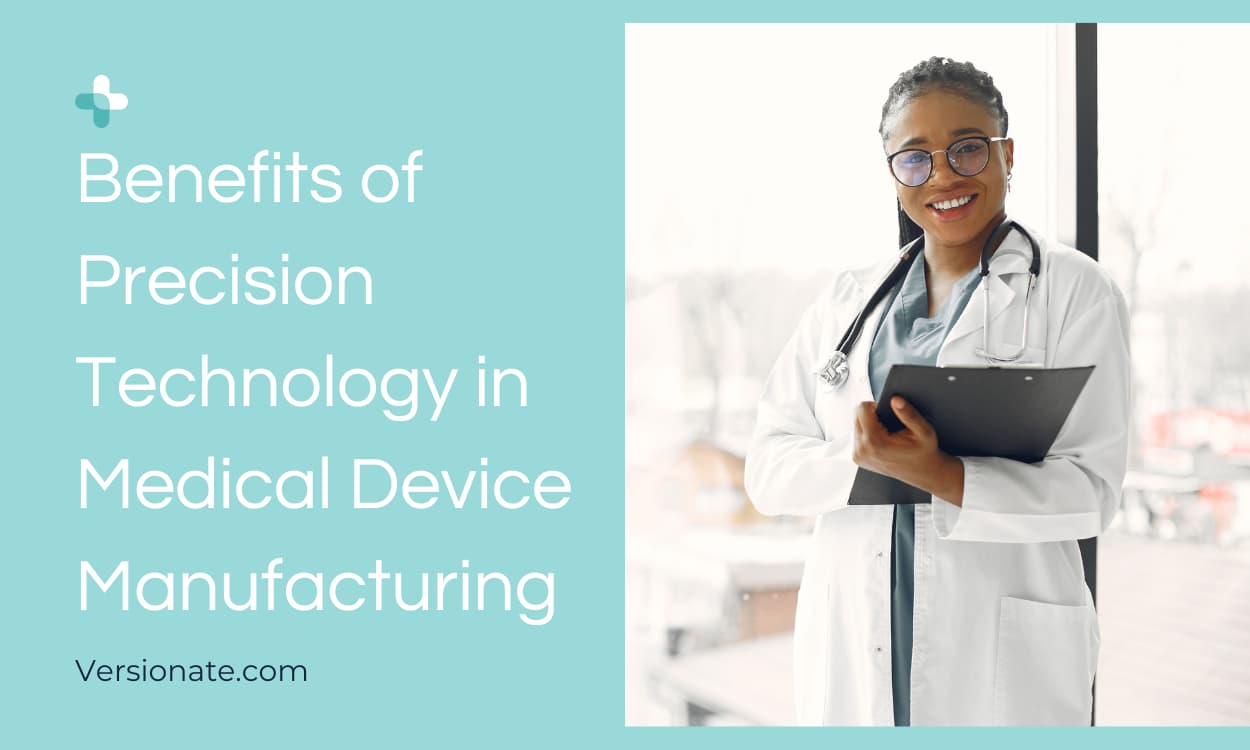In the world of healthcare, precision is paramount, especially when it comes to manufacturing medical devices.
These devices play a crucial role in diagnosing, treating, and monitoring patients, and even the tiniest error can have severe consequences.
That’s why embracing precision technology in the production process is vital for ensuring that every medical device meets the highest standards of quality and safety.
Benefits of Precision Technology in Medical Device Manufacturing

Key Takeaways
- Precision technology is essential for manufacturing high-quality, safe, and effective medical devices.
- Advanced engineering software and intelligent automation improve product quality and production efficiency.
- The future of medical device manufacturing looks promising with the integration of IoT and ongoing technological advancements.
The Importance of Precision in Medical Device Manufacturing
Imagine you or a loved one needing a medical device, like a pacemaker or an insulin pump. You’d want to be sure that the device is made with the utmost precision, right?
Well, that’s exactly what precision technology aims to achieve in medical manufacturing CPQ.
Precision technology involves using advanced tools, software, and techniques to create medical devices that are:
- Accurate: Devices are made to the exact specifications required for optimal performance.
- Consistent: Each device is identical, ensuring reliable results and outcomes.
- Safe: Precision manufacturing minimizes the risk of defects or malfunctions that could harm patients.
The Evolution of Manufacturing Technologies in Healthcare
Over the years, the way we manufacture medical devices has changed a lot. In the past, most devices were made by hand, which was time-consuming and left room for human error. But now, we have all sorts of high-tech tools and machines that help us make devices more efficiently and precisely.
Some of the key advancements in medical device manufacturing include:
- Automation: Robots and automated systems can perform repetitive tasks with incredible accuracy, reducing the risk of errors.
- 3D printing: This technology allows manufacturers to create complex device components layer by layer, enabling more intricate designs and faster production.
- Advanced materials: New materials, like biocompatible polymers and lightweight alloys, are being used to create devices that are stronger, safer, and more comfortable for patients.
| Traditional Manufacturing | Advanced Manufacturing |
|---|---|
| Manual assembly | Automated systems |
| Limited customization | 3D printing for personalized devices |
| Basic materials | Innovative, biocompatible materials |
The Role of Configurators in Custom Medical Solutions
One of the coolest things about precision technology is that it allows manufacturers to create custom medical devices tailored to a patient’s specific needs. This is where configurators come in handy.
A configurator is a software tool that helps manufacturers design and produce custom devices quickly and accurately.
Here’s how it works:
- Healthcare professionals input the patient’s requirements and specifications into the configurator.
- The software generates a custom device design based on those inputs.
- The design is sent to the production team, who use precision manufacturing techniques to bring the device to life.
Configurators are a game-changer for patients who need specialized devices, like prosthetics or orthotics, because they ensure a perfect fit and optimal functionality.
Enhancing Product Quality with Advanced Engineering Software
Another way precision technology is transforming medical device manufacturing is through the use of advanced engineering software.
These powerful tools help engineers design and test devices virtually before they’re even produced, which saves time and resources while improving product quality.
Some of the benefits of using advanced engineering software include:
- Improved accuracy: Software can simulate device performance and identify potential issues before production begins.
- Faster iterations: Engineers can make design changes and test them virtually, speeding up the development process.
- Better collaboration: Cloud-based software allows teams to work together seamlessly, even if they’re in different locations.
Streamlining Production with Intelligent Automation
Remember those robots and automated systems we mentioned earlier? They’re a big part of what makes precision technology so effective in medical device manufacturing. By streamlining production processes, intelligent automation helps manufacturers create devices more efficiently and consistently.
Here are a few examples of how automation is used in medical device manufacturing:
- Assembly: Robots can assemble device components with incredible speed and accuracy, reducing the risk of human error.
- Quality control: Automated inspection systems can detect defects or irregularities in devices, ensuring that only the highest quality products make it to patients.
- Packaging: Automated packaging systems can ensure that devices are properly sealed and labeled, reducing the risk of contamination or mix-ups.
Integrating IoT and Smart Factories into Medical Device Production
The Internet of Things (IoT) is another exciting development in precision technology for medical device manufacturing. By connecting machines, sensors, and software, IoT enables smart factories that can monitor and optimize production processes in real time.
Some of the benefits of integrating IoT into medical device manufacturing include:
- Real-time monitoring: Sensors can track production processes and alert manufacturers to potential issues before they become problems.
- Predictive maintenance: By analyzing data from connected machines, manufacturers can predict when equipment needs maintenance, reducing downtime and extending machine life.
- Supply chain optimization: IoT can help manufacturers track inventory levels and shipments, ensuring that they always have the materials they need to keep production running smoothly.
Addressing Regulatory Compliance with Technology
Medical device manufacturers face strict regulations to ensure that their products are safe and effective for patients. Precision technology can help manufacturers meet these regulatory requirements more easily and efficiently.
For example, advanced software can help manufacturers:
- Document processes: Create detailed records of production processes, materials, and testing results, which are essential for regulatory compliance.
- Manage quality control: Automate quality control processes and generate reports that demonstrate compliance with standards.
- Track and trace: Monitor the movement of devices through the supply chain, from raw materials to final delivery, ensuring that they meet all regulatory requirements along the way.
The Future of Medical Device Manufacturing
As precision technology continues to evolve, the future of medical device manufacturing looks brighter than ever. An insightful perspective on these burgeoning trends can be found in resources such as MedTech Intelligence on Future Trends.
Some of the exciting developments on the horizon include:
- Personalized medicine: Advances in 3D printing and bioprinting could enable the creation of fully customized devices and even living tissues for individual patients.
- Artificial intelligence: AI-powered systems could help manufacturers optimize production processes, predict demand, and identify new opportunities for innovation.
- Nanotechnology: Tiny sensors and devices could be used to monitor patient health in real time, enabling earlier diagnosis and more targeted treatments.
Patient Safety and the Importance of Precision Engineering
At the end of the day, the most important thing about precision technology in medical device manufacturing is that it helps keep patients safe. By ensuring that devices are accurate, consistent, and reliable, precision engineering can:
- Reduce complications: Minimize the risk of device malfunctions or failures that could harm patients.
- Improve outcomes: Help patients receive the most effective treatments and achieve better health outcomes.
- Enhance quality of life: Enable patients to manage chronic conditions more easily and comfortably, improving their overall well-being.
Collaboration Between Engineers and Health Professionals
To fully realize the benefits of precision technology in medical device manufacturing, engineers and health professionals need to work together closely.
By collaborating throughout the design and production process, these experts can ensure that devices meet the needs of both patients and providers.
Some of the ways engineers and health professionals can collaborate include:
- Needs assessment: Health professionals can provide input on the specific needs and requirements of patients and providers, helping engineers design devices that meet those needs.
- Prototyping and testing: Engineers can create prototypes of devices for health professionals to test and provide feedback on, ensuring that the final products are safe, effective, and user-friendly.
- Training and education: Health professionals can provide training and education to engineers on the clinical applications and implications of their devices, helping them design better products in the future.
FAQs:
- How does precision technology help reduce the risk of device defects?
- Precision technology uses advanced tools and techniques to ensure that devices are made to exact specifications, minimizing the risk of errors or inconsistencies that could lead to defects.
- What role does 3D printing play in medical device manufacturing?
- 3D printing enables manufacturers to create complex device components and even custom devices more quickly and efficiently than traditional manufacturing methods.
- How can IoT help optimize medical device production?
- IoT-connected sensors and machines can monitor production processes in real time, alerting manufacturers to potential issues and enabling predictive maintenance to keep production running smoothly.
- Why is collaboration between engineers and health professionals important in medical device manufacturing?
- Collaboration ensures that devices meet the needs of both patients and providers, with health professionals providing input on clinical requirements and engineers designing products that are safe, effective, and user-friendly.
Conclusion:
Precision technology is transforming the way we manufacture medical devices, enabling the creation of products that are more accurate, consistent, and reliable than ever before.
From advanced engineering software and intelligent automation to IoT and 3D printing, these technologies are helping manufacturers meet the highest standards of quality and safety for the patients who depend on their devices.
As we look to the future, ongoing advancements in precision technology hold even more promise for medical device manufacturing.
By continuing to collaborate closely with health professionals and embrace innovations, manufacturers can create devices that not only improve patient outcomes but also enhance the overall quality and efficiency of healthcare.
At the end of the day, precision technology is more than just a set of tools and techniques – it’s a commitment to putting patients first and ensuring that every medical device is made with the utmost care and accuracy.
And that’s a commitment that benefits us all.



